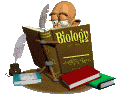
Chapter
21: Genetics of Development
AP Biology
Stoneleigh-Burnham School
a journey into the living world!
| Judith
S. de Nuño |
WebSites http://www.jdenuno.com/ |
Office
Hours |
Cyber
Office Hours First Class Chat |
